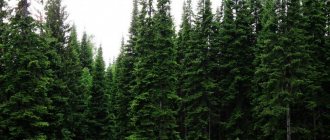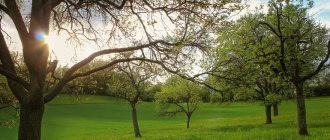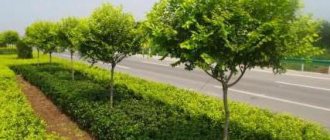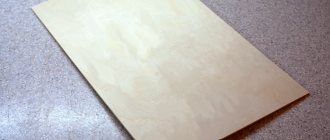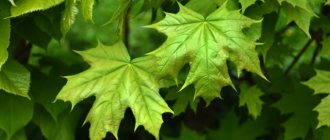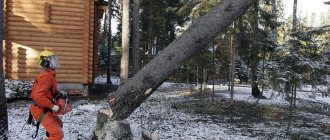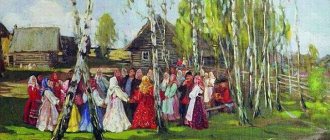Fir (abies) is an evergreen tree or shrub from the Pine family. Externally, the plant is very similar to spruce, and in the structure and direction of growth of cones - to cedar. Most representatives are distributed from the tropics to the Arctic Circle of the Northern Hemisphere. The largest number of fir trees is concentrated in western Canada, the USA and East Asia. Depending on the type, fir trees are heat-loving or frost-resistant, but all are sensitive to drought and stagnant water. Fir is used in the woodworking industry, landscaping, and in folk medicine.
Here you will learn:
Botanical description
Fir is an evergreen tree that grows up to 30 meters. The characteristic thin branches reach to the ground. The bark of the tree is gray in color, smooth in structure with characteristic thickenings filled with aromatic resin.
Another name is fir balsam. It differs from other coniferous trees in its cone-shaped shape, starting at the base of the trunk. The needles remain green in winter. The lower part of the needles is decorated with two white lines.
The photo of the fir shows what beautiful needles it has. The buds developing at the ends are protected by scales coated with a layer of resin. The needles are not prickly, glossy, deep green. Male flowers look like earrings made of cones, while female flowers are cylindrical in shape. Pollination occurs by wind.
As the seeds ripen, the scales on the cones harden and fall off, releasing light, winged seeds. The root system of the plant is strong, core-like, going deep into the ground. Fir blooms in May.
When describing fir, one cannot fail to mention its exceptional medicinal qualities, which are widely used in medicine.
Types and varieties of perennials
In total, 50 plant species are registered in the fir genus.
Korean fir. The inhabitant of high-mountain Asia and South Korea is part of mixed forests. The tree has a wide cone-shaped crown. It grows up to 15 m in height. The light gray bark has a red-brown or purple tint. Dense needles 10-15 mm long have a hard surface and saber-shaped shape. It is characterized by a dark green color. Cylindrical cones of violet-purple color grow 5-7 cm in length. Popular varieties:
- Silberlok is a low (up to 200 cm) conical tree covered with dark green needles with silver-white stripes at the base;
- Diamond is a dwarf (0.3-0.60 m) plant with an oval bright green crown.
Korean
fir Siberian fir. A slender tree with an openwork crown grows 30 m in height. Almost from the very ground it is covered with thin branches with smooth dark gray bark. Gradually, deep cracks appear in the bark. The variety produces a large amount of fragrant transparent resin (fir balsam). Dark green needles with a waxy coating last up to 7-10 years. Flowering occurs in May, and fruit ripening occurs in September-October.
Siberian fir
Balsam fir. The inhabitant of North America is found off the coast of the Atlantic and Pacific oceans. It is a slender tree 15-25 cm high with a cone-shaped crown. The needles are 15-25 mm long and have a blunt edge and a small notch at the end. Light stripes are visible at the base of the glossy dark green needles. Oval purple strobili grow 5-10 cm long and 20-25 mm in diameter. Varieties:
- Nana is a low, spreading shrub, 0.5 m in height and up to 2.5 m in width. It is distinguished by short (only 4-10 mm in length) dark green needles;
- Piccolo is a rounded bush up to 40 cm in diameter with dense, closely spaced branches strewn with dark green needles.
Balsam fir
Caucasian fir (Nordmann). Trees about 60 m in height are found along the Black Sea coast of the Caucasus and Turkey. They have a narrow, cone-shaped crown. Due to its high density, it almost does not transmit light. The buds are devoid of resin. Dark green needles grow 1-4 cm in length. In early May, green cones appear, which gradually turn dark brown. The length of the cones is 12-20 cm.
Caucasian fir
Fraser fir. The tree grows in the mountains of the southeastern United States. It has a conical or columnar crown and reaches 12-25 m in height. The bark of young shoots is smooth gray, and the bark of old shoots is scaly red-brown. Short (up to 20 mm) needles are dark green in color. The oblong female strobili, about 3.5-6 cm in length, have a purple tint when they appear, but then turn yellow-brown. The variety is famous for its good frost resistance.
Fraser fir
Single-color fir (concolor). The tree, up to 60 m high and with a trunk diameter of up to 190 cm, lives in the mountainous regions of the western United States. It is actively used in the woodworking industry. The plant has gray smooth bark and branches perpendicular to the trunk. Flat green needles with a slight blue or whitish tint are curved in a crescent shape. Their length is 1.5-6 cm. Cones appear in May. The males are smaller, collected in groups and colored purple or red. Female, oval ones grow 7-12 cm in length. They have a light green tint.
Fir one color
White fir (European or comb). The tree, 30-65 m high, is common in Southern and Central Europe. The pyramidal or oval translucent crown consists of horizontal or raised branches covered with flat dark green needles 2-3 cm long. Female cylindrical cones grow 10-16 cm in length. They change color from green to dark brown.
White fir
White fir. The tree, 30 m high, has a narrow, symmetrical, conical crown. The shoots are covered with smooth silver-gray bark. Slightly forked soft needles reach 1-3 cm in length. It is dark green in color and has bluish-white stripes at the base. The upward-pointing cylindrical cones, 45-55 mm long, are purple when they appear, but become dark brown.
White fir
Fir planting and care
Four-year-old seedlings are planted in open ground in April or early autumn. It is advisable that on the day of planting the weather outside is cloudy and rainy. The ideal soil for fir is moist loam.
14 days before planting and caring for fir in the open ground, you should dig a hole 60x60x60. Dimensions may vary depending on the total volume of the seedling's roots. After the pit is prepared, it is filled with 20-30 liters of water. When it is absorbed into the ground, the bottom of the hole should be dug up to 15 cm, crushed stone or broken brick should be filled in at a level of 5 cm.
Next, the dug hole is half filled with a specially prepared soil mixture, consisting of the following components:
- Peat - 1 part;
- humus - 3 parts;
- sawdust - 10 kg;
- clay - 2 parts;
- nitrophoska - 300 g;
- sand - 1 part.
After half a month, when the soil in the dug hole has settled, the rhizome of the seedling is placed in the hole, leaving the root collar flush with the surface of the summer cottage. The roots are straightened, the hole is filled with the soil mixture and thoroughly compacted. Next, according to the planting rules, the seedling must be watered.
In addition to watering, caring for the plant involves loosening the soil around the planted fir and removing weeds. It is advisable to sprinkle a circle of seedlings with a diameter of half a meter with sawdust in a layer of 5 cm without touching the root collar of the plant.
The rules for caring for fir imply the first feeding after planting two years later. To do this, in the spring, granular fertilizer Kemira-universal is used in the tree trunk circle in an amount of 100-125 g. Gardeners have long valued this fertilizer for the absence of chlorine in its composition and a large amount of selenium useful for plants.
Fir is watered depending on the type. If the fir is a moisture-loving variety, then watering should be frequent, which cannot be said about balsam fir. Over the entire season, it is enough to water it 3 times. When watering once, you need to pour two buckets of water under each tree.
There are varieties that do not need additional moisture; natural precipitation is enough for them. The procedure for replanting a fir tree is practically no different from independently planting a seedling purchased from a nursery.
Plant care
Fir requires care based on the needs of the tree, based on the time of year and the characteristics of the land in place. Trees planted in decorative containers require special control. They need to water and fertilize more often.
Young seedlings need moisture more, especially those with a powerful root system. After planting, the plant must be watered for 15 days. It is also necessary to do the same with trees that grow in containers.
The tree should be watered no more than 3 times during the growing season, as this tree is drought-resistant. If the summer is very dry, then create 2 waterings within a month.
Do not forget to loosen and weed the soil around the tree as a result of each watering. In autumn and spring, cover the circle around the trunk with mulch for better storage of moisture in the ground. Use sawdust or pine needles as mulch. The earth will be more permeable to air and moisture due to this.
Feeding and pruning
There is no need to fertilize frequently, since the tree is not picky about them. Perform the main fertilizing no earlier than 3 years after planting the tree. Use special liquid substances such as those used for coniferous trees.
Korean fir does not need pruning. But in order to achieve very thick and spreading needles, it is very important to trim the shoots in the center. Every year it is necessary to remove dried needles, branches and cones; it is thanks to this that the decorative appearance of the tree is improved.
Korean fir is very simple to care for and grow, but you need to successfully select the variety for planting in advance and the place in which the tree will feel very comfortable. And if everything goes well and the tree is accepted, then it will be the most beautiful and problem-free attribute on your site.
How to shape a fir crown
Korean fir is trimmed in the spring. As a rule, the crown is cleaned, removing dried and very damaged branches. Fir trees have a neat, regular crown shape, but if suddenly due to some factors additional formation is needed, it is done in early spring, before sap flow begins. Sometimes it is not only large trees that need to create a crown, but also small ones and spreading cultivars.
Most types and decorative forms of fir grow successfully without any winter cover. Still, it is necessary to remember that young individuals in the first year after planting are most sensitive to low temperatures. As a rule, they are covered with spruce branches, which protects them from both spring cold and sunburn, especially severe ones when the snow melts. It is useful to dust the tree trunks of young plantings with dry leaves or mulch with peat for the winter.
Trimming
Garden pruning work is carried out in the spring until the sap flow stage. It is necessary to remove dry branches and broken branches. You can also start molding the crown during this period. All pruning work is carried out using garden shears.
Every gardener should know that you cannot shorten the stem by more than a third in one haircut. Most fir trees have an even crown that does not require shaping.
Etymology of the name [edit | edit code ]
A. G. Preobrazhensky in his dictionary reports that “fir is a tree
Abies sibirica;
fir; dial Sib. fir - fir forest
. Borrowed from it. Fichte “spruce”, also “pine”, “fir”; folk borrowing" [3]. Earlier, the same idea was expressed by the Czech linguist Antonin Macenauer [cs] “fir - Russian. Pinus picea “spruce”, “pine” from it. Fichte." M. Vasmer is of the same opinion, citing A. Preobrazhensky and A. Matzenauer [4]
V. A. Merkulova proposed a different version of the origin of the word “fir”. Her opinion is that the Russians could have borrowed the word pihk
,
pihku
meaning "large dense forest" or "pine forest", "pine tree" from Western Finnish languages.
In Olonets and Arkhangelsk dialects, the lexeme fir
is found in the meaning of “small spruce thicket” and “pine forest” and could easily be transferred to the name of a coniferous tree.
Wed. in Finnish languages pihk
is a large dense forest,
pihku
is pine,
pihka
is resin.
In the last example, pihka
(where
-ka
is perceived as a diminutive suffix, that is, pivka “small frequent young forest”, “dense small forest”) from Finn.
pihka
[5] [6] .
Procurement of seeds
Fir seeds are obtained from collected cones. They must be immature. At home, the cones are dried and the seeds are extracted from them. Then they are treated with a solution of potassium permanganate, washed with warm water and soaked for a day.
After swelling for a day, the seeds are placed in fabric bags with damp sand and put in a cool place until sowing.
Sowing seeds
Seeds are sown at the end of March. The soil mixture should be sandy loam; fresh sawdust is poured onto it in a 2 cm layer. Seeds are laid on this layer and sprinkled with sawdust again. Next, the seeds are watered with water and covered with film. They are opened in the morning and evening to ventilate the crops.
It is important not to overdo it with waterlogging to prevent the seeds from rotting. As soon as the first shoots appear, the film is removed. During the summer, it is recommended to feed the seedlings three times with mineral fertilizers.
Propagation by cuttings
Cuttings for fir propagation are cut from branches with an apical bud that have grown this year. Shoots from young 4-8 year old trees take root well. Typically, the length of the petioles is 10-25 cm. At the bottom of the petiole, 5 cm of needles are removed. This distance is equal to the planting depth.
The cuttings are planted in a greenhouse. Drainage from pebbles is laid out at the bottom of the container in a layer of 4 cm, then turf soil is covered in a layer of 12 cm, and sprinkled with river sand on top. After this, the top is covered with a film material that should not come into contact with the sand. It is necessary to create a free space of about 30 cm between the covering material and the top layer of sand.
Before planting, the petioles are dipped to half their length for 24 hours in a solution of a growth stimulator. The temperature in the greenhouse should be 20 C.
At the next stage, the petioles are planted in the sand at an angle of 45 degrees, at a distance of 10 cm from each other. After the planting process, the cuttings should be watered abundantly.
In spring, watering is carried out once a day, in summer - 4 times a day. Closer to autumn, when the roots grow, the plant needs daily watering.
Pests and diseases
According to reviews from experienced breeders, fir is quite resistant to diseases and dangerous insects, but sometimes it is affected by hermes fir. This aphid causes yellowing of branches and death of needles. To get rid of such a scourge, use a solution of the drug Antio or Rogor. The entire tree, including the trunk, is sprayed with these insecticides.
Often, the beautiful fir suffers from fungal rust, which causes rusty spots on the shoots and their yellowing. To save the plant, its crown is treated with a 2% boron solution, the affected branches are cut and burned, and the cut areas are soaked with garden pitch.
If a white coating appears on a young fir shoot, this is a sign of the appearance of winged aphids. Sometimes it is enough to prune the branches affected by the pest, but if the pathogens have spread deeper, the crown will need to be treated with insecticidal solutions.
When a spider mite appears, the fir needles begin to change color and quickly fall off. A tincture of dandelion flowers helps kill it. Vegetable infusions (tomato and onion) are used to treat a tree if caterpillars that secrete mucus begin to multiply on it. To boost natural immunity, it is advisable to water and spray young fir seedlings, as well as adult trees, with bio-preparations, for example, Ecosil or Novosil, once a year. They are made from organic compounds, as well as fir needles and resin.
Varieties
Despite the huge variety of species and varieties, when grown on site, the following are especially popular:
- Balsam fir - used in landscape design of rocky gardens and terraces. Gray, variegated, silver and dwarf varieties are grown;
- Korean fir is one of the most popular species. Among the varieties, a special place is occupied by the following varieties: Blue Standard, Brevifolia, Piccolo;
- Caucasian fir - grows only in the Caucasus, but some subspecies take root in other regions. It is distinguished by dense needles and a thick aroma.
There are Fraser fir, equally scaly fir, Sakhalin fir, Greek fir, whitebark fir, European fir, Semenov fir, myra fir, and Vicha fir.
In a beauty contest among coniferous plants, fir could easily win the main prize. Fluffy coat, cones in the shape of candlesticks - these features make it a favorite in many household plots. But to maintain this beauty, proper care will be required.
Features and interesting facts about coniferous trees
The main features of conifers are cones and needles; their presence distinguishes coniferous trees from deciduous trees.
Coniferous forests are one of three types of forests present on our planet. The air in these forests is the most healing, so sanatoriums and dispensaries for people with lung diseases are often built next to coniferous oak forests. It has been scientifically proven that by inhaling the air of coniferous forests, you can improve your health and get a boost of energy for a long time. Coniferous trees grow everywhere - in the Siberian taiga, on the Mediterranean coast, in the mountains, and on distant islands. Instead of leaves, they have needles - needles, which are gradually replaced by new ones. Therefore, almost all coniferous trees are evergreen. Before buying coniferous trees, it is important to know about their characteristics. One of the characteristics of conifers is that these trees do not have flowers where seeds could grow. They hide their seeds in cones, which are modified shoots that grow at the ends of branches. At first the cones are green and tender, and then become covered with scales and harden. They have the most varied shapes.
Coniferous trees: spruce, fir, larch and pine
The main feature of a coniferous tree such as spruce is the emergence of young shoots-clones from the roots of a dead tree. Thanks to this, it grows again. In Sweden, in Fulufjellet National Park, there is a specimen that has been continuously self-cloning for over 9,550 years. This organism is considered the oldest on our planet. An interesting fact about this coniferous tree is that spruce can live up to 300 years and its age is not difficult to find out. After all, the branches on it grow in tiers. The first tier appears when the tree is 4-5 years old. And then every year one floor is added, and from them you can determine how old the tree is.
Along with green firs, there are also white ones. The peculiarity of this coniferous plant is the presence of white stripes on the needles. Unlike other coniferous trees, fir has cones that grow upward and the needles are flat.
Unlike other coniferous trees, larch sheds its needles at the same time as leaves.
The needles of Scots pine are arranged two in a bunch (whorl). In the art of bonsai, the proportions of a small tree correspond to its large prototype in nature. An interesting fact about this coniferous tree is that you can grow a pine tree at home, but it will be small. The art of growing small copies of large trees is developed in Japan and China and is called “bonsai”. Trees are kept small through constant pruning and other special techniques.
Cedar or pine? Interesting facts about cedar and pine
Cedar is the name given to various coniferous trees. The real Himalayan cedar grows in Lebanon, on the slopes of the Himalayas, at an altitude of up to 3600 m. So, what is correct - cedar or pine? The fact is that Siberian cedar is a type of pine. Its scientific name is Siberian pine. Three types of cedar pine grow in Russia: Siberian cedar, Korean cedar and dwarf cedar, or cedar. So pine nuts are actually pine nuts!
Pine nuts are, strictly speaking, seeds. They are not only tasty, but also very healthy. Valuable oil is made from these nuts. Imagine how much work it takes to collect pine cones, peel them, remove the nuts and squeeze the oil out of them.
Scots pine seeds are lightweight and therefore easily transported by the wind. An interesting fact about this coniferous plant: the seeds of the Siberian pine are pine nuts. Her pine cones are too heavy and just fall to the ground. However, young cedars cannot grow under the shade of old trees. A nutcracker bird comes to their aid. She deftly removes nuts from the cones, eats some, and takes a few with her in her beak and hides them in her pantry - a secluded place among the mosses. The nutcracker has several such hiding places, and not all of them are returned to later. Forgotten nuts overwinter under the snow and germinate in the spring. Thanks to the humble bird, mighty cedars spread throughout the taiga.
Lebanese cedar has served people since ancient times. It was from this tree that Phoenician sailors built their ships. An interesting fact about cedar is that this tree is the national symbol of Lebanon (the successor of ancient Phenicia). The cedar is featured on the coat of arms and flag, and this country's highest honor is the National Order of the Cedar. In the north of Lebanon, in the mountains, is the Divine Cedar Forest, which is recognized as a UNESCO World Heritage Site.
Interesting facts about cypress and its history
The history of cypress is the most ancient of all coniferous trees. Plants of this kind grew already several tens of millions of years ago. One of the interesting facts about cypress is that its needles can only be seen on young plants, while mature trees and shrubs have leaves that are small, scale-like, with a free upper part. Cypress trees grow in warm regions - on the coasts of the Mediterranean and Black Seas, in the Himalayas, in southern China, in North America and even in the oases of the Sahara.
Evergreen cypress is very common in the Mediterranean. This tree has a spreading crown, but with the help of selection, a pyramidal cypress with a crown directed upward was created. Such trees can reach 52 m. In many cities and rural areas in southern Italy, entire cypress alleys are planted. And in one city there is a law that states that everyone who wants to build a house must plant a cypress tree.
Cypress wood is soft and light, it is not affected by fungus, and the smell repels insects.
It contains a lot of resin and therefore preserves well. The ancient Egyptians made sarcophagi from cypress, and used cypress oil to embalm mummies. There is also a legend according to which Noah's Ark was built from cypress.
The tallest tree in Asia is the Kashmir cypress. Its homeland is northern India and Bhutan in the Himalayas. This is a very beautiful tree that is often planted in yards. In nature it grows very quickly and can reach 45 m.
udec.ru
